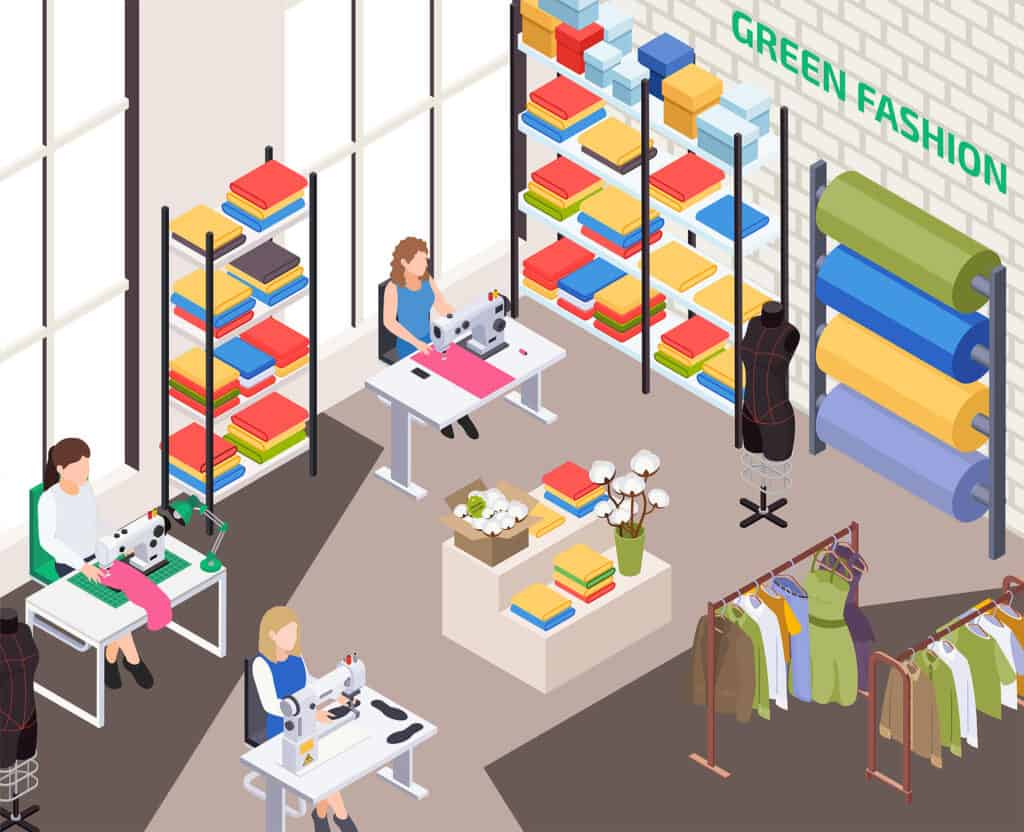Energy Efficiency in Sustainable Fashion
As someone deeply passionate about environmental conservation and conscious consumerism, I've been closely following the remarkable transformation taking place in the fashion industry towards sustainability.
Among the many facets of this shift, one that particularly resonates with me is the relentless drive to enhance energy efficiency in apparel manufacturing. Recognizing that reducing energy consumption is a crucial step toward minimizing the industry's carbon footprint, I find it inspiring how fashion brands are stepping up to contribute to a greener future.
In this guide, I'm eager to delve into the significance of energy efficiency in sustainable fashion and share practical strategies that we, as consumers, can support to help reduce the energy impact of clothing production. Together, we can play a vital role in shaping a more environmentally friendly fashion landscape.
Why Energy Efficiency Matters in Fashion
Environmental Impact
The fashion industry is known for its substantial environmental footprint. High energy consumption contributes to greenhouse gas emissions, air and water pollution, and the depletion of natural resources. Embracing energy efficiency is a crucial step in mitigating these impacts.
Cost Savings
Energy-efficient practices not only benefit the environment but also yield financial advantages for fashion brands. Lower energy consumption translates into reduced operational costs, enabling companies to allocate resources to sustainable initiatives.
Brand Reputation
Consumers increasingly demand transparency and sustainability from the fashion industry. Brands that prioritize energy efficiency and environmental responsibility can enhance their reputation and appeal to conscious consumers.
Regulatory Compliance
Many countries and regions are implementing stricter regulations and standards regarding energy consumption and environmental impact. Fashion brands that invest in energy efficiency are more likely to stay compliant with these evolving regulations, avoiding potential fines and legal issues.
Resource Conservation
Energy efficiency isn't just about electricity; it also extends to the efficient use of materials and resources in the production process. By optimizing their manufacturing and supply chain operations, fashion companies can reduce waste and minimize the need for raw materials, contributing to a more sustainable industry.
Innovation and Competitiveness
Embracing energy-efficient technologies and practices can foster innovation within the fashion industry. Companies that invest in research and development to create eco-friendly products and processes can gain a competitive edge and stay ahead of market trends.
Long-Term Viabilit
Sustainability is not just a passing trend; it's becoming an integral part of business strategy. Fashion brands that prioritize energy efficiency are more likely to ensure their long-term viability in an industry that is increasingly focused on environmental and social responsibility.

Challenges of High Energy Consumption in Apparel Manufacturing
Apparel manufacturing stands out as an energy-intensive industry, driven by a range of intricate processes including dyeing, printing, sewing, and more. Within this context, it's essential to delve deeper into the challenges associated with the sector's high energy consumption, as they encompass a multitude of facets:
- Fossil Fuel Dependency: A significant hurdle lies in the apparel industry's heavy reliance on fossil fuels for energy generation. Coal and natural gas often power factories, contributing significantly to carbon emissions. This not only impacts the environment but also exacerbates the industry's overall carbon footprint.
- Outdated Machinery: Another notable challenge is the prevalence of outdated machinery and equipment within manufacturing facilities. These aging machines are often energy-inefficient, consuming excessive amounts of power, which can be both costly and environmentally detrimental. Upgrading to more efficient technology is an imperative yet costly undertaking for many manufacturers.
- Complex Global Supply Chains: The intricate web of global supply chains inherent to the apparel industry also plays a role in escalating energy consumption. The transportation of raw materials, components, and finished products across vast distances demands substantial energy resources. Additionally, managing these intricate supply chains efficiently is a daunting task in itself.
- Fast Fashion Phenomenon: The fast fashion business model, characterized by rapid production cycles and disposable clothing, is a driving force behind heightened energy consumption and waste generation. The need to produce new items quickly leads to energy-intensive production processes, and the disposable nature of fast fashion results in garments being discarded at an alarming rate, further straining the environment.
- Water Usage: In addition to energy consumption, apparel manufacturing places considerable demand on water resources. Dyeing and finishing processes, in particular, require substantial water usage, leading to potential environmental issues and water scarcity concerns.
- Chemical Usage: The use of various chemicals in textile production can exacerbate the industry's environmental impact. Chemicals used for dyeing, finishing, and fabric treatment can have adverse effects on both the environment and worker health if not properly managed.
- Waste Generation: High energy consumption often correlates with increased waste generation. Manufacturing processes in the apparel industry can generate considerable waste, including fabric offcuts, defective products, and packaging materials, contributing to landfill congestion and environmental degradation.
- Lack of Awareness: A lack of awareness and commitment to sustainable practices can hinder progress. Some manufacturers may not fully grasp the potential benefits of energy efficiency and sustainability, or they may struggle to navigate the complexities of implementing such practices.
- Evolving Regulations: The constantly evolving landscape of environmental regulations and standards poses a challenge for apparel manufacturers. Staying compliant with these regulations can be resource-intensive, especially for smaller and less technologically advanced facilities.
Strategies for Reducing Energy Use
Fashion brands aiming to make substantial strides in energy efficiency can employ a range of multifaceted strategies that extend across their entire supply chain. These strategies encompass not only environmental benefits but also cost savings and competitive advantages:
Sustainable Materials Selection
Initiating change begins at the source. Opting for sustainable and low-impact materials can profoundly impact energy consumption during production. Materials like organic cotton, recycled fibers, and Tencel have gained prominence for their reduced energy requirements compared to conventional alternatives. By prioritizing such materials, brands not only lower their carbon footprint but also align with consumer demands for eco-conscious choices.
Eco-Friendly Production Techniques
Beyond material selection, brands can implement eco-friendly production techniques that significantly diminish energy and resource consumption. Innovations such as digital printing and waterless dyeing have revolutionized the industry by minimizing water usage and energy expenditure. Incorporating these methods into manufacturing processes can lead to substantial reductions in energy consumption, benefiting both the environment and operational costs.
Supply Chain Optimization
Energy efficiency isn't limited to factory walls; it extends to supply chain management. Brands can streamline their supply chains to curtail unnecessary transportation and energy expenditure. This includes sourcing materials locally to reduce transportation emissions, optimizing shipping routes to minimize energy consumption, and reducing lead times through efficient planning and inventory management. Such measures not only conserve energy but also enhance supply chain resilience and responsiveness.
Energy-Efficient Machinery
The heart of apparel manufacturing lies in machinery, and upgrading to energy-efficient equipment is pivotal. Modern machinery, designed with energy efficiency in mind, consumes less power while maintaining or even improving production output. Regular maintenance practices further optimize machinery performance, ensuring that energy isn't wasted due to equipment inefficiencies. Investing in state-of-the-art technology is an investment in long-term sustainability.
Transition to Renewable Energy Sources
A transformative step towards energy efficiency involves transitioning to renewable energy sources to power manufacturing facilities. Solar, wind, and other renewable energy options can dramatically reduce the carbon footprint of apparel production. Brands can consider on-site renewable energy installations or purchase renewable energy credits to support sustainable energy generation. This transition not only aligns with environmental goals but also demonstrates a commitment to clean energy and carbon neutrality.
Data-Driven Efficiency
Harnessing the power of data analytics and monitoring systems can be a game-changer in optimizing energy use. Brands can implement real-time monitoring of energy consumption across their operations, identifying areas of inefficiency and making data-driven decisions to enhance energy performance. Such data-driven insights allow for continuous improvement and fine-tuning of energy-saving initiatives.
Collaborative Efforts
Collaboration within the industry and with supply chain partners is essential. Brands can work collectively with suppliers to encourage sustainable practices, energy-efficient manufacturing, and shared environmental goals. Collaborative efforts can drive systemic change and accelerate the adoption of sustainable energy practices throughout the fashion industry.
Employee Engagement
The engagement of employees in energy-saving initiatives cannot be underestimated. Brands can foster a culture of sustainability within their organizations, encouraging employees to identify and champion energy-saving opportunities. Employee education and involvement can lead to innovative solutions and a more holistic approach to energy efficiency.

Case Studies of Energy-Efficient Fashion Brands
Examining real-world examples of fashion brands that have made substantial strides in energy efficiency provides valuable insights into successful implementation.
Here are three case studies showcasing how these pioneering brands have integrated energy efficiency into their operations, going beyond the surface to adopt holistic approaches to sustainability:
Patagonia: Pioneering Environmental Stewardship
Patagonia, renowned for its unwavering commitment to environmental responsibility, stands as a beacon of sustainability in the fashion industry. Beyond its iconic outdoor apparel, Patagonia has made significant investments in energy efficiency.
They have transitioned to energy-efficient facilities and embraced renewable energy sources for their manufacturing processes. This comprehensive approach has resulted in substantial reductions in both energy consumption and carbon emissions.
By integrating sustainability into their core values, Patagonia exemplifies how energy efficiency can align with a brand's broader commitment to environmental stewardship.
Eileen Fisher: Illuminating Sustainability from Within
Eileen Fisher, a prominent advocate for sustainable fashion, goes beyond the runway to illuminate the path to energy efficiency. Within their stores and offices, the brand has implemented energy-efficient lighting and heating systems, exemplifying how energy savings extend beyond production facilities.
Moreover, Eileen Fisher has forged strategic partnerships with manufacturers that employ sustainable production techniques. These partnerships not only reduce energy consumption but also underscore the brand's dedication to fostering sustainable practices throughout the fashion supply chain.
Eileen Fisher's multifaceted approach illustrates that energy efficiency is not confined to a single aspect of operations but permeates every facet of the brand's commitment to sustainability.
H&M Conscious Collection: Striving for a Renewable Future
H&M, a global fashion giant, has embarked on an ambitious journey towards energy efficiency and sustainability with its Conscious Collection.
Beyond using sustainable materials, this collection prioritizes energy-efficient production processes. H&M has set robust goals, aiming to power its operations with 100% renewable energy.
This forward-looking vision represents a profound commitment to energy efficiency, not only in their products but also in their entire operational framework. By setting such high standards, H&M illustrates that energy efficiency is integral to achieving a renewable future in fashion.
The Role of Consumers in Promoting Energy Efficiency
Consumers wield significant influence in propelling the fashion industry towards energy efficiency and sustainability. Their choices and actions can steer the market in a more environmentally responsible direction. Here's a deeper exploration of the multifaceted role consumers play in promoting energy efficiency:
- Support Sustainable Brands – Beyond the Surface: Selecting fashion brands that actively prioritize energy efficiency and sustainability is a potent way to drive change. However, consumer support should delve beyond surface-level claims. Look for brands that provide transparent information about their energy-efficient practices, sourcing of sustainable materials, and overall environmental commitment. By endorsing such brands, consumers send a clear message that sustainability matters.
- Educate Yourself – Empowering Informed Choices: Knowledge is a formidable tool. Consumers can educate themselves about the fashion industry's environmental impact, from energy consumption to water usage and waste generation. Informed consumers are better equipped to make conscious choices that align with their values. Resources, such as sustainability reports and environmental impact assessments provided by brands, can be invaluable in this educational journey.
- Extend Product Lifespan – Reducing the Ripple Effect: An often underestimated but potent way consumers can drive energy efficiency is by extending the lifespan of their clothing. By caring for garments, repairing when necessary, and considering secondhand or vintage shopping, consumers indirectly reduce the energy required for the production of new items. The longer a piece of clothing remains in use, the less energy is expended on its replacement, thereby lessening the industry's overall energy burden.
- Advocate for Change – Mobilizing Consumer Influence: Consumers possess collective power that extends beyond their purchases. They can use their voices and collective action to demand greater transparency and sustainability from fashion brands. This advocacy can take various forms, from engaging with brands on social media to participating in campaigns that highlight the importance of energy efficiency and environmental responsibility. Additionally, consumers can advocate for policies and regulations that incentivize and enforce energy-efficient practices within the fashion industry, amplifying their impact on a systemic level.
- Support Innovation and Accountability: Consumers can champion and reward fashion brands that invest in innovative, energy-efficient technologies and practices. Recognize and celebrate those brands that are not only reducing their energy footprint but also openly sharing their progress and challenges. By endorsing brands that prioritize accountability and continuous improvement, consumers help foster a culture of transparency and innovation within the fashion industry.
FAQs on Sustainable Fashion and Energy Efficiency
What is the significance of energy efficiency in the fashion industry's sustainability efforts?
Energy efficiency is essential in the fashion industry's sustainability journey because it helps reduce environmental impact. Lower energy consumption leads to decreased carbon emissions, pollution, and resource depletion, aligning with sustainable goals.
How can energy-efficient practices benefit the financial health of fashion brands?
Energy-efficient practices can result in cost savings for fashion brands. Reduced energy consumption lowers operational expenses, allowing brands to allocate resources towards sustainable initiatives and potentially improving their financial performance.
How does prioritizing energy efficiency enhance the reputation of fashion brands?
Fashion brands that prioritize energy efficiency and environmental responsibility can bolster their reputation among consumers who value sustainability. This focus on eco-consciousness can attract conscious consumers and build stronger brand loyalty.
Are there regulations in place regarding energy consumption within the fashion industry?
Yes, many countries and regions are introducing stricter regulations and standards regarding energy consumption and environmental impact in the fashion industry. Brands that invest in energy efficiency are more likely to comply with these evolving regulations, avoiding potential fines and legal issues.
How does energy efficiency relate to resource conservation in the fashion industry?
Energy efficiency in fashion extends beyond electricity usage; it also encompasses efficient use of materials and resources during production. By optimizing manufacturing and supply chain operations, fashion companies can reduce waste and lessen their reliance on raw materials, contributing to a more sustainable industry.
How can energy efficiency drive innovation and competitiveness in the fashion industry?
Fashion brands that adopt energy-efficient technologies and practices can stimulate innovation within the industry. By investing in research and development for eco-friendly products and processes, companies can gain a competitive edge and stay at the forefront of market trends.
Conclusion
Energy efficiency in sustainable fashion is not just a trend; it's a necessity for the industry's long-term viability and the health of our planet. By reducing energy consumption in apparel manufacturing, fashion brands can make significant strides toward mitigating environmental harm, lowering costs, and building a positive brand image.
The challenges are substantial, but with innovative materials, eco-friendly production techniques, supply chain optimization, and a commitment to renewable energy, fashion brands can make a profound impact on the future of fashion. Consumers, too, have a crucial role to play by supporting energy-efficient brands and demanding sustainability.
As we move forward, the fashion industry has an opportunity and a responsibility to lead the way towards a more energy-efficient and sustainable future.
Sources:
- https://www.ncbi.nlm.nih.gov/pmc/articles/PMC8257395/
- https://www.sustainability.vic.gov.au/energy-efficiency-and-reducing-emissions/in-a-business/by-sector/energy-efficiency-in-fashion-and-textiles
- https://www.ncbi.nlm.nih.gov/pmc/articles/PMC7380204/
- https://www.mdpi.com/2071-1050/15/13/9986
- https://publications.parliament.uk/pa/cm201719/cmselect/cmenvaud/2311/2311.pdf
- https://www.ilo.org/wcmsp5/groups/public/—asia/—ro-bangkok/documents/publication/wcms_800026.pdf

